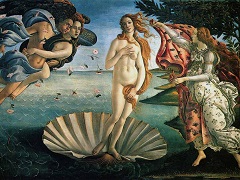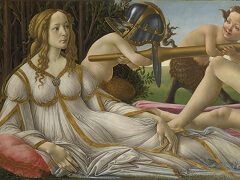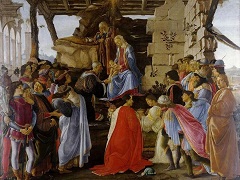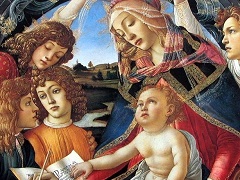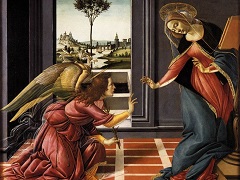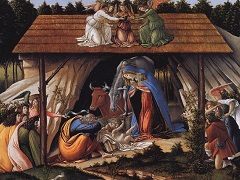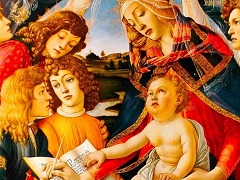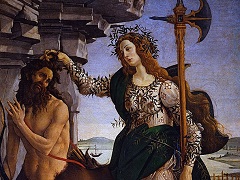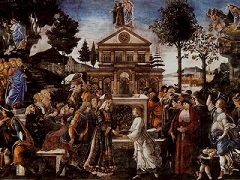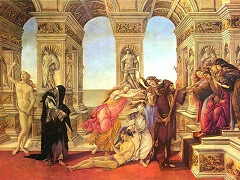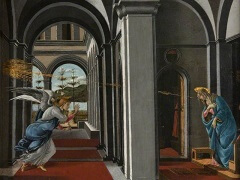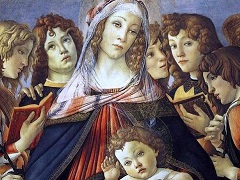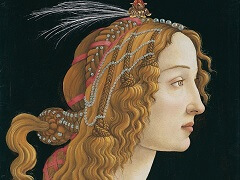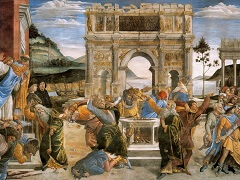Primavera, 1482 by Sandro Botticelli
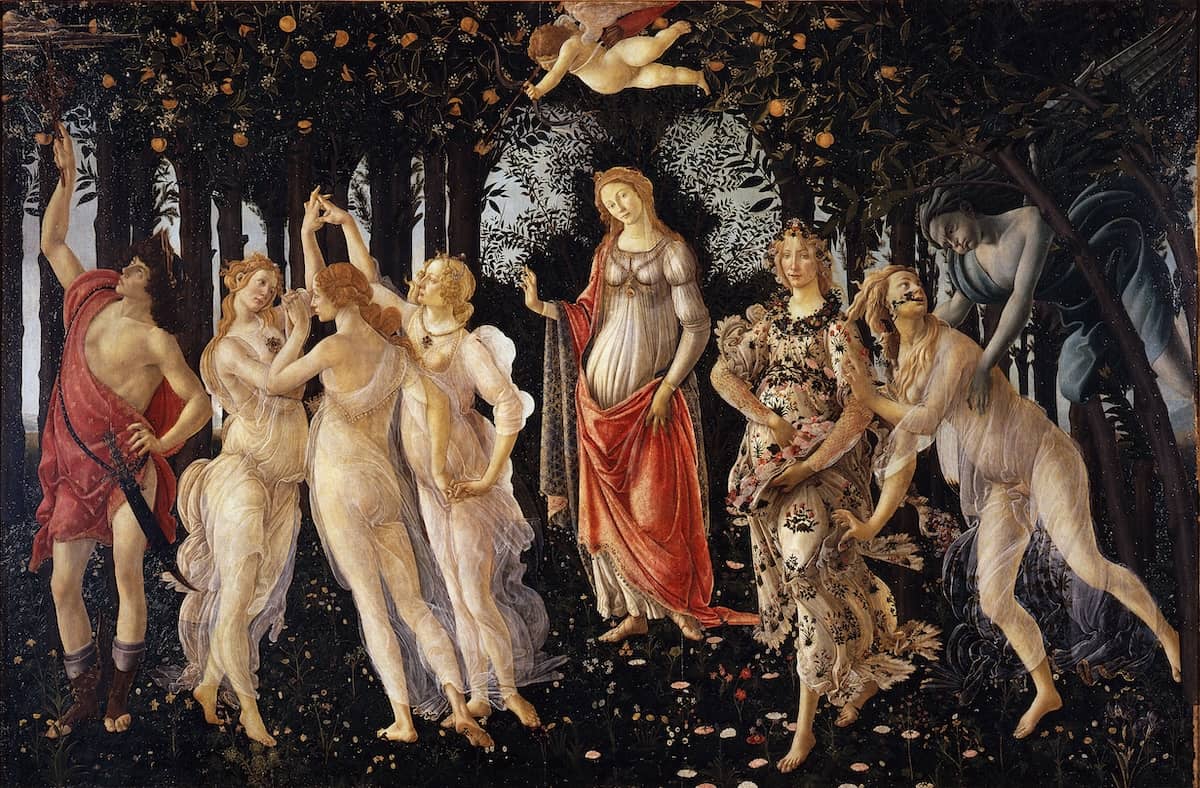
After returning from Rome in the spring of 1482, Botticelli executed a series of mythological paintings in the course of the decade which constitute the basis of his fame as an artist today. One of the best known of these paintings, if also without doubt the most puzzling and most discussed among them, is The Primavera, the exact meaning of which remains unclear to this day. For a long time it was assumed that the picture had been painted for Lorenzo the Magnificent, ruler of Florence at the time. However, this supposition has been disproved by recent studies. According to a recently discovered inventory, in 1499 the painting could be found in the Florentine city palace of Lorenzo di Pierfrancesco, a cousin twice removed of Lorenzo the Magnificent. In all probability, therefore, the painting was executed for this same Lorenzo di Pierfrancesco, from the younger branch of the Medici family. After the death of his father, this man grew up in the care of Lorenzo the Magnificent, who designated Giorgio Antonio Vespucci, Botticelli's neighbour and greatest admirer, as one of his charge's tutors. The young Lorenzo di Pierfrancesco will doubtless have heard via this man of Botticelli, who was to become his preferred painter.
We know from the aforementioned inventory that Botticelli's Primavera was to be found in an anteroom to Lorenzo di Pierfrancesco's bed-chamber. The picture was surrounded by a white frame and hung directly above the back-rest of a sofa, which would explain not only the length of the painting but also the sharply rising perspective of the meadow on which the eight figures in the picture appear. According to the inventory, two further paintings hung in the room, namely a Virgin and Child by an unknown painter and Botticelli's Pallas and the Centaur, placed over the door as a sopraporta. We will see that all three paintings were interrelated from the point of view of content and constituted a unity.
As indicated by the picture's title - itself known to have been in use by the 16th century - Primavera represents the arrival and celebration of Spring. Venus, Goddess of Love, appears in the middle of an orange grove, on a meadow adorned with flowers; overhead, her son, Amor, his eyes blindfolded, is shooting his arrows of love. Mistress of this grove, Venus has fallen back a little, as if wishing to give her retinue the opportunity to overtake her. The posture and movement of the pictorial figures are echoed by the form of the trees, resulting in a harmonious unity of man and nature. The erect stature of the orange trees echoes the figures standing upright beneath them, while the bending laurel trees on the right-hand side imitate the posture of the fleeing nymph. The orange trees come together over Venus' head to form a semicircular arch; halo-like, it surrounds the Goddess as the primary figure in the picture.
Venus appears in her garden, which Angelo Poliziano, the Medici court poet, portrayed in his verse as the place of eternal spring and peace. His poetic descriptions may have provided Botticelli with the model for his painting. Thus entrance is permitted Zephyrus, the gentle wind who bathes the meadows in dew, wraps them in sweet scents and clothes the earth with innumerable flowers. The God of Winds appears on the right-hand side of the picture as a bluish-green winged being. He is powerfully filling his cheeks, so as to pour out his warm breezes. However, Zephyrus' intentions are revealed as being less peaceful than Poliziano describes them. Instead, the God of Winds is forcing his way into the garden, causing the trees to bend. He is pursuing a nymph clad in transparent garments, who is turning around fearfully to look at him. Flowers are unfolding from her mouth, mingling with those lavishly adorning the robe of the woman pacing along next to her. The latter is reaching with her hand into her gathered-up dress, in order to strew the abundance of roses collected therein throughout the garden. The key to this apparently puzzling scene may be found in a written source from antiquity, namely the "Fasti", a Roman calendar of festivals by Ovid. In his work, the poet portrays the beginning of spring as the transformation of the nymph Chloris into Flora, Goddess of Flowers: "Once I was Chloris, who am now called Flora", the nymph commences her account, as flowers stream forth from her mouth. Zephyrus, so she laments, was fired with wild passion upon catching sight of her, pursued her, and took her by force. Since he regretted the violence of his actions, however, he transformed her into the Flower-Goddess of Spring. The subject matter of the three-figure group on the right-hand side of the picture is thus the arrival of spring as portrayed by Ovid in his calendar. This explains why the garments of the two female figures are blowing in different directions, since we can now understand them as representing two separate moments in Ovid's narrative and thus occurring at different points in time.
The sensual, violent nature of Zephyrus, aflame with passion, something so alien to Poliziano's poem, may be encountered in a further written source, one which will similarly have served as a model for Botticelli's representation. We are concerned here with the philosophical poem "De Rerum Natura" by Lucretius, the classical poet and philosopher, who describes the awakening of sensual, physical love within the context of the arrival of spring, and thus also that of Zephyrus: On the left-hand side of the picture, we see the three Graces, companions of Venus, dancing a roundelay in a charming manner. They are followed by Mercury, Messenger of the Gods, with whom the painting concludes on the left. He may be identified by means of his winged shoes, and also by-the staff in his raised right hand, the so-called caduceus. around which two snakes are winding themselves. Classical mythology has it that Mercury used his staff to separate two fighting snakes, upon which the staff became the symbol of peace. And it is in this sense that it should be understood in Botticelli's painting: Mercury is using it to drive away some clouds which are threatening to force their way into Venus' garden. Thus it is that he becomes the protector of the garden, in which there are no clouds and where eternal peace reigns. Mercury's ability to defend the grove as its guardian is further underlined by the conspicuous nature with which his sword is displayed, a symbol that he is capable of driving away enemies at any time.

